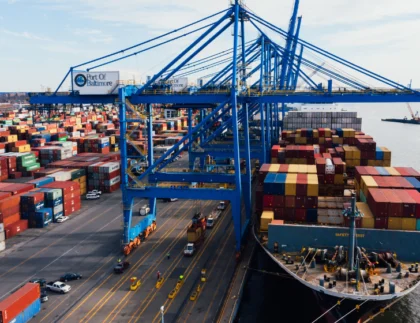
In today's rapidly evolving global commercial landscape, freight forwarding is crucial for ensuring the seamless transportation of goods across international borders. As markets grow increasingly dynamic, traditional static pricing methodologies in freight forwarding are demonstrated to be inadequate.
Introducing adaptive freight pricing, a strategy that utilizes Artificial Intelligence (AI) to enable real-time modifications to pricing.
This approach enhances freight cost management and bolsters logistics profitability.
The Shift Towards Adaptive Freight Pricing
Traditional freight pricing primarily relies on historical data and predetermined margins, which may result in complications in a market characterized by fluctuating demand and supply.
Adaptive freight pricing addresses this challenge by utilizing AI-driven algorithms to analyze real-time data, enabling dynamic pricing that reflects current market conditions. This market-oriented pricing strategy ensures that rates remain competitive while aligning with operational expenditures and customer expectations.
The Role of AI in Real-Time Pricing
AI has revolutionized freight cost management by introducing real- ime pricing models that dynamically respond to market fluctuations. Unlike traditional pricing mechanisms, which rely on historical data and fixed margins, AI logistics systems process vast amounts of real-time information to adjust freight rates instantly based on demand, capacity, and external variables.
Superior Cost Optimization
AI streamlines rate adjustments, ensuring accuracy and consistency across multiple shipping routes and modes of transport. This automation minimizes human errors and enables logistics companies to operate more efficiently.
By utilizing machine learning algorithms, artificial intelligence can forecast fluctuations in market-driven pricing by analyzing variables, including global shipping trends, fuel prices, route congestion, weather conditions, and competitor rates. This forecasting ability enables freight forwarders to adopt demand-based pricing, wherein costs are modified dynamically under market requirements.
During periods of high demand, AI recognizes opportunities to optimize revenue through rate increases, whereas, during slower periods, it recommends competitive pricing strategies to draw in shippers.

Incorporating Real-time Operational Data
AI also enhances dynamic pricing by incorporating real-time operational data, such as available fleet capacity and warehouse space. By assessing supply chain efficiencies, AI-driven systems enhance shipping rates to guarantee that freight forwarders retain profitability while sustaining cost competitiveness. Furthermore, sophisticated AI models can identify emerging trends and suggest proactive pricing modifications, ensuring companies remain at the forefront of market changes.
Another essential element of an AI-driven freight rate strategy is its capability to customize pricing for various clients. AI can adjust pricing according to customer preferences, shipping frequency, and contractual arrangements by utilizing historical transaction data and behavioural analytics.
This degree of personalization not only enhances customer satisfaction but also fortifies enduring business relationships.
Moreover, AI facilitates automation in freight cost management, reducing the need for manual intervention in pricing decisions. By integrating with freight management systems,
AI streamlines rate adjustments, ensuring accuracy and consistency across multiple shipping routes and modes of transport. This automation minimizes human errors and enables logistics companies to operate more efficiently.
Superior Cost Optimization
With the capacity to analyze substantial datasets and utilize instantaneous insights, AI-driven real-time pricing signifies a considerable transformation in the freight forwarding sector. As technology advances, enterprises incorporating AI into their pricing strategies will experience enhanced logistics profitability, superior cost optimization, and a more pronounced competitive advantage in the international marketplace.
Benefits of Dynamic Pricing in Freight Forwarding
1.Enhanced Competitiveness: By employing dynamic pricing strategies, freight forwarders can offer rates responsive to market fluctuations, thereby improving their competitiveness with organizations that utilize static pricing models.
2. Improved Profit Margins: Real-time adjustments enable organizations to take advantage of peak demand periods by accurately increasing rates, thereby enhancing logistics profitability.
3.Optimised Resource Utilisation: Adaptive pricing can impact client behaviour by offering reduced rates during off-peak periods, enhancing resource allocation and cost-effectiveness.
4. Customer Satisfaction:Transparent and fair pricing models build customer trust, enhancing satisfaction and loyalty.

Implementing AI-Driven Pricing Strategies
To effectively execute AI-driven freight rate strategies, organizations ought to take into account the subsequent steps:
1.Data Integration: Combine data from numerous sources, such as shipment records, market insights, and operational costs, to create a solid foundation for AI analysis
2.Algorithm Development: Develop AI algorithms capable of processing integrated data to identify patterns and predict market trends, facilitating real-time pricing adjustments.
3.Continuous Monitoring and Adjustment: Regularly evaluate the efficacy of pricing strategies and modify algorithms to adapt to evolving market conditions.
4.Customer Communication:Maintain transparency with clients about pricing models to foster trust and effectively manage expectations.
Challenges and Considerations
While the advantages are considerable, the implementation of AI-driven adaptive freight pricing presents specific challenges:
- Data Quality and Availability : Accurate and comprehensive data is essential for practical AI analysis. Incomplete or erroneous data can lead to suboptimal pricing decisions.
- Integration with Existing Systems : Incorporating artificial intelligence solutions into legacy systems may necessitate substantial investment and technical proficiency.
- Market Acceptance : Customers accustomed to traditional pricing models may require education and reassurance to accept dynamic pricing structures.
The Future of Freight Pricing
As international trade becomes increasingly intricate, implementing AI-driven adaptive freight pricing will likely establish itself as a norm within the sector. Companies that embrace this technology will be better equipped to navigate market volatility, optimize costs, and effectively meet customer demands.
As international trade becomes increasingly intricate, implementing AI-driven adaptive freight pricing will likely establish itself as a norm within the sector. Companies that embrace this technology will be better equipped to navigate market volatility, optimize costs, and effectively meet customer demands.
By leveraging AI for real-time pricing, freight forwarders can transform challenges into opportunities, ensuring sustained growth and profitability in a competitive landscape.

In conclusion, Integrating artificial intelligence into freight forwarding pricing strategies represents a noteworthy progression within the industry. Adaptive freight pricing not only overcomes the constraints of conventional models but also provides a forward-thinking approach to navigating market dynamics.
The capabilities of artificial intelligence will improve freight cost management and logistics profitability as technology advances.











